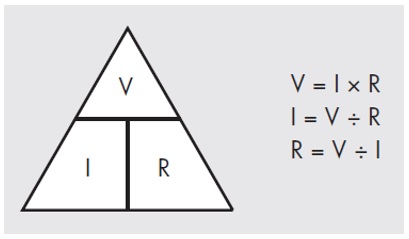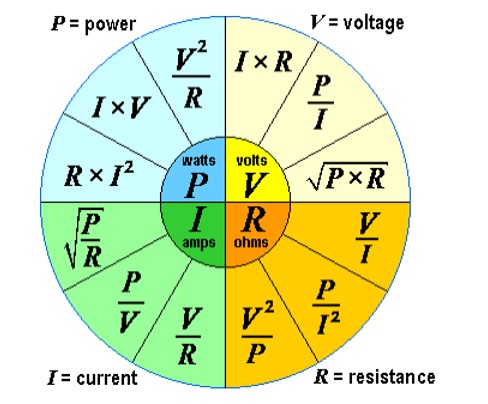Ohm's Law
Ohm's Law states that the relationship between current, resistance, and voltage is as follows: The current in a circuit is directly propositional to the applied voltage and inversely proportional to the resistance.
voltage (V) = current (I) × resistance (R)
Understanding this relationship is important for fast, accurate electrical problem diagnosis and repair.
If you know two of the quantities, then you can calculate the third. A popular way to remember Ohm's Law is with a triangle.

Example: A 12-volt battery produces a current in the circuit of 0.5 A. What is the resistance?
R = V/I = 12 / 0.5 = 24 ohms.
The power wheel calculator
The power wheel calculator simplifies the calculation of all main electric parameters, i.e. voltage, current, power, and resistance; and clarifies the relation between these parameters.

Fill in the blanks
1) What is the algebraic formula for Ohm's law?
A) ______________
2) Find the Resistance for each combination of voltage
and current values using ohm's law?
i) V = 5 Volt I = 2 ampere R = _________
ii) V = 9 Volt I = 1 ampere R = _________
iii) V = 5 Volt I = 0.02 ampere R = _________
3) Find the voltage for each combination of resistance
and current values using ohm's law?
i) R = 200 ohm I = 5 ampere V = _________
ii) R = 500 ohm I = 2 ampere V = _________
iii) R = 1000 ohm I = 1 ampere V = _________
4) Find the current for each combination of voltage
and resistance values using ohm's law?
i) V = 5 Volt R = 200 ohm I = _________
ii) V = 9 Volt R = 250 ohm I = _________
iii) V = 5 Volt R = 500 ohm I = _________
Answers
1) V = I x R 2) i) 2.5 ii) 9 iii) 250
3) i)1000 ii)1000 iii) 1000
4) i) 0.025 ii) 0.036 iii) 0.01